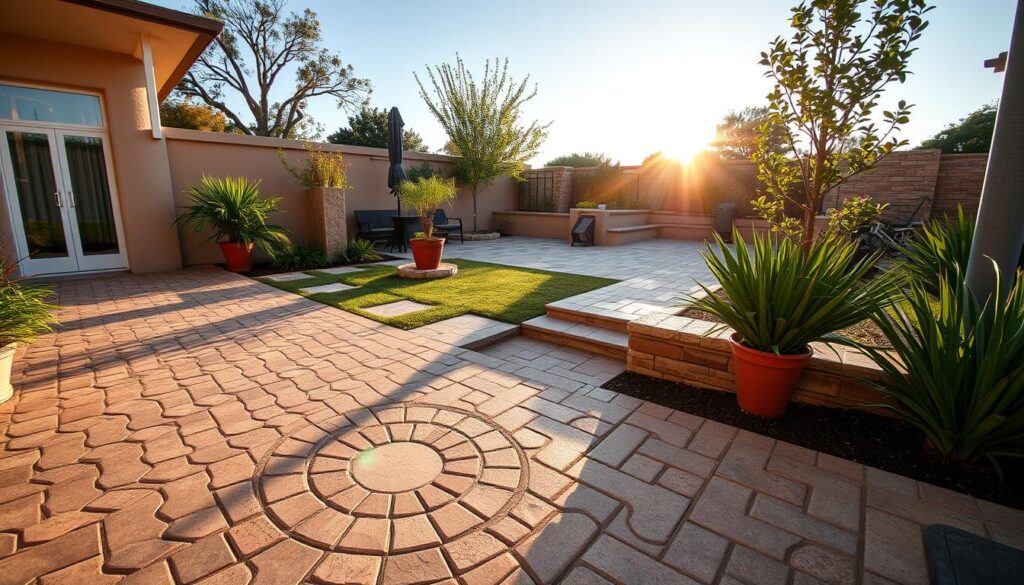Did you know that a well-designed outdoor space can increase your home’s value by up to 12%? Transforming your outdoor area into a beautiful and functional living space starts with creative pavement design project ideas. Custom paving solutions can turn any backyard into an inviting oasis, perfect for relaxation or entertainment.
With the right outdoor paving ideas, you can create a seamless transition between your indoor and outdoor living areas. Whether you’re looking to install a new patio, pathway, or driveway, custom pavement designs can enhance the aesthetic and functionality of your outdoor space.
Key Takeaways
- Custom paving solutions can increase your home’s value.
- A well-designed outdoor space enhances livability.
- Outdoor paving ideas can transform any backyard.
- Seamless transitions between indoor and outdoor areas are possible.
- Pavement design projects can be tailored to your needs.
1. Introduction to Pavement Design
Creative pavement designs can transform any outdoor area into a beautiful and functional part of your home. Pavement design is not just about choosing materials; it’s about creating a seamless integration between your outdoor spaces and the natural surroundings.
Pavement design involves planning and designing the layout and features of outdoor surfaces such as driveways, walkways, and patios. A well-designed pavement can significantly enhance the curb appeal of your property, making it more inviting and increasing its overall value.
What is Pavement Design?
Pavement design encompasses a range of activities, from selecting the right materials to determining the layout that best suits your outdoor space. It requires a balance between aesthetics and functionality, ensuring that the pavement is not only visually appealing but also durable and safe.
The process involves understanding the purpose of the pavement, the expected traffic, and the environmental conditions it will be exposed to. For instance, a driveway might require more durable materials than a garden pathway.
Benefits of Thoughtful Design
Thoughtful pavement design offers numerous benefits, including enhanced property value, improved safety, and increased functionality. A well-designed pavement can also contribute to the overall aesthetic appeal of your property, making it stand out in the neighborhood.
“A well-designed pavement is not just a pathway; it’s an extension of your home’s personality.”
Some of the key benefits of thoughtful pavement design include:
- Increased property value
- Improved safety through proper drainage and surface texture
- Enhanced aesthetic appeal
- Better functionality, such as easier access to different areas of your property
| Design Element | Benefits | Considerations |
|---|---|---|
| Material Selection | Durability, Aesthetic Appeal | Cost, Maintenance Requirements |
| Layout Design | Functionality, Safety | Traffic Flow, Drainage |
| Decorative Elements | Aesthetic Appeal, Personalization | Cost, Theme Consistency |
By incorporating modern pavement concepts and creative designs, homeowners can create outdoor spaces that are not only functional but also beautiful and inviting.
2. Understanding Different Pavement Types
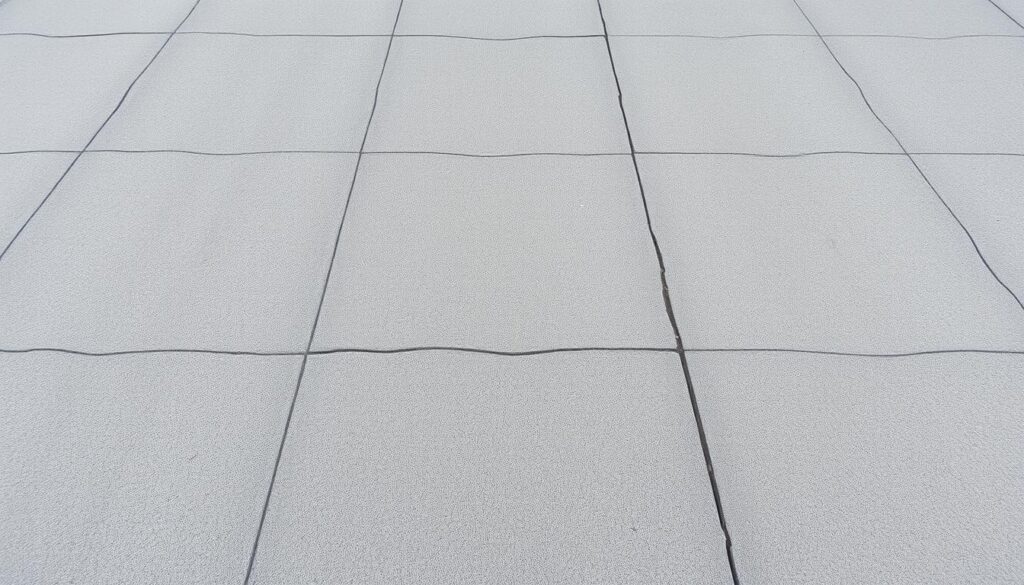
Different pavement types offer unique benefits and aesthetic options, making it essential to understand their characteristics. The choice of pavement can significantly impact the overall look and feel of your outdoor area, as well as its functionality.
Concrete Pavements
Concrete pavements are a popular choice due to their durability and versatility. They can be finished in various ways to achieve decorative pavement patterns, such as stamping, staining, or exposing aggregate. This makes them suitable for a wide range of design styles, from modern to traditional.
One of the key advantages of concrete pavements is their ability to withstand heavy loads and harsh weather conditions. They are also relatively low maintenance, as they can last for decades with proper care.
Asphalt Pavements
Asphalt pavements are another common choice, known for their flexibility and cost-effectiveness. They are particularly suitable for driveways and large areas where a smooth, continuous surface is desired. Asphalt can be sealed or coated to enhance its appearance and durability.
For those interested in learning more about different pavement construction methods, including asphalt, visiting resources on road construction can provide valuable insights.
Permeable Pavements
Permeable pavements are an innovative solution that allows water to pass through the surface, reducing runoff and filtering out pollutants. They are made from porous materials like permeable concrete, porous asphalt, or interlocking pavers. This type of pavement is ideal for areas where stormwater management is a concern.
Permeable pavements not only help in managing stormwater but also contribute to recharging groundwater. They are a great example of unique paving solutions that combine functionality with environmental sustainability.
| Pavement Type | Key Characteristics | Typical Applications |
|---|---|---|
| Concrete Pavements | Durable, versatile, low maintenance | Patios, walkways, driveways |
| Asphalt Pavements | Flexible, cost-effective, smooth surface | Driveways, large parking areas |
| Permeable Pavements | Porous, reduces runoff, environmentally friendly | Areas with stormwater management concerns |
3. Choosing the Right Material for Your Project
The success of your pavement project heavily relies on choosing the right material. With various options available, each with its unique benefits and drawbacks, making an informed decision is crucial.
Factors to Consider
When selecting a pavement material, several factors must be taken into account. Durability is a key consideration, as it directly impacts the lifespan of the pavement. Maintenance requirements also play a significant role, as some materials demand more upkeep than others.
The climate in your region is another critical factor. For instance, in areas with heavy rainfall, permeable pavements can be an excellent choice, as they allow water to percolate through, reducing runoff. In contrast, in regions with intense sunlight, materials with high UV resistance are preferable.
Cost Analysis
Conducting a thorough cost analysis is essential to ensure that the chosen material fits within your project budget. This involves not only the initial installation costs but also long-term expenses, including maintenance and potential repairs.
| Material | Initial Cost | Maintenance Cost | Lifespan |
|---|---|---|---|
| Asphalt | $2-$5 per sq ft | $0.50-$1 per sq ft/year | 15-20 years |
| Concrete | $4-$10 per sq ft | $0.25-$0.50 per sq ft/year | 25-30 years |
| Permeable Pavers | $10-$20 per sq ft | $0.50-$1 per sq ft/year | 20-25 years |
By carefully evaluating these factors and conducting a comprehensive cost analysis, you can make an informed decision that suits your DIY driveway project or innovative sidewalk design, ensuring a successful and cost-effective outcome.
4. Popular Pavement Design Ideas for Patios
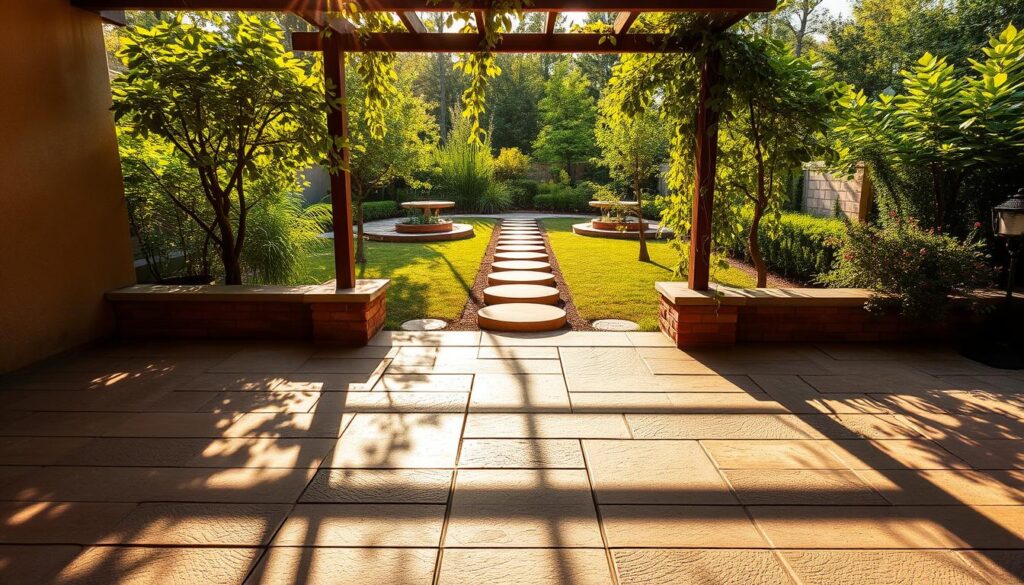
Creative pavement designs can turn an ordinary patio into an extraordinary outdoor oasis. By incorporating thoughtful pavement designs, homeowners can enhance the functionality and aesthetic appeal of their outdoor spaces.
Cozy Outdoor Living Spaces
Creating a cozy outdoor living space involves more than just furniture; it’s about designing an inviting area that encourages relaxation and socialization. Pavement plays a crucial role in this design. For instance, using stamped concrete or decorative pavers can add texture and visual interest to the patio, making it a warm and welcoming space.
To further enhance the coziness, consider integrating outdoor lighting into your pavement design. Solar-powered lights or low-voltage LED lights can be embedded into the pavement to create a soft glow, perfect for evening gatherings.
| Pavement Material | Aesthetic Appeal | Durability |
|---|---|---|
| Stamped Concrete | High | High |
| Decorative Pavers | High | Medium |
| Asphalt | Low | High |
Stylish Pathways and Walkways
Stylish pathways and walkways not only guide visitors through your outdoor space but also add to its visual appeal. Using creative pavement designs for pathways can create a sense of journey and discovery in your garden or yard.
For a modern look, consider using large format pavers or concrete slabs for your pathways. These materials can create a clean and sleek appearance, perfect for contemporary outdoor designs.
By incorporating these popular pavement design ideas, homeowners can create patios that are not only functional but also visually appealing. Whether it’s through cozy outdoor living spaces or stylish pathways, the right pavement design can elevate the entire outdoor area.
5. Unique Driveway Designs
Elevate your home’s exterior with unique driveway designs that make a lasting impression. A driveway is more than just a path to your garage; it’s a statement piece that sets the tone for your entire property.
Unique driveway designs, such as circular driveways and border designs, can significantly enhance your property’s curb appeal. These designs offer a range of creative possibilities for homeowners looking to make a statement.
Circular Driveways
Circular driveways are a classic choice that exudes elegance and sophistication. They provide a convenient and visually appealing way to access your home. According to experts, circular driveways can be particularly effective in larger properties where space is not a concern.
“A circular driveway is not just a practical solution; it’s a design element that can elevate the entire aesthetic of your home,” says a leading landscape designer. This design can be further enhanced with landscaping and lighting to create a truly unique look.
Border Designs
Border designs offer another creative way to enhance your driveway. By incorporating different materials or patterns along the edges of your driveway, you can create a visually appealing contrast that adds to your home’s curb appeal.
For instance, using brick or stone borders can add a touch of elegance, while a simple concrete border can provide a clean, modern look. The key is to choose a design that complements your home’s architecture and landscaping.
When it comes to unique paving solutions, the possibilities are endless. Homeowners can choose from a variety of materials and designs to create a driveway that reflects their personal style. Whether you opt for a circular driveway or a creative border design, the right choice can significantly enhance your home’s exterior.
6. Eco-Friendly Pavement Solutions
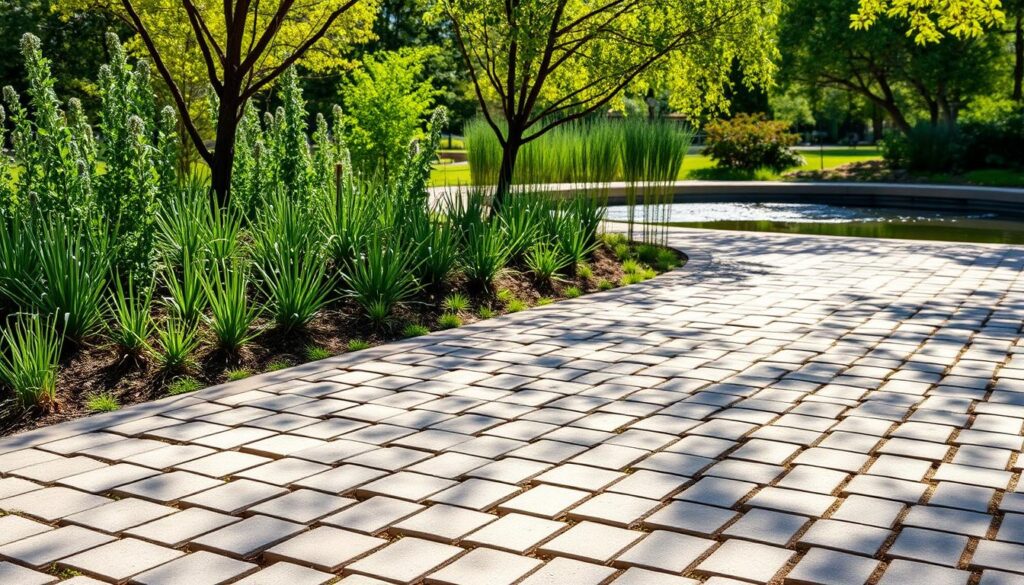
Eco-friendly paving options are revolutionizing the way we design outdoor spaces, offering sustainable alternatives to traditional materials. As concern for the environment continues to grow, homeowners and builders are seeking greener solutions for pavement projects.
The use of eco-friendly pavement solutions not only contributes to environmental sustainability but also enhances the aesthetic appeal of outdoor spaces. These solutions are designed to reduce the environmental footprint of pavement projects, making them an attractive choice for those looking to create sustainable landscapes.
Sustainable Material Options
One of the key aspects of eco-friendly pavement solutions is the use of sustainable materials. These materials are sourced and manufactured in ways that minimize environmental impact. Some examples include:
- Recycled concrete aggregate
- Porous asphalt
- Permeable interlocking concrete pavers
For more information on sustainable pavement materials and ideas, you can refer to the Sustainable Pavement Ideas Repository provided by the California Department of Transportation.
Benefits of Permeable Paving
Permeable paving is a highly effective eco-friendly pavement solution that allows water to percolate through the surface, reducing stormwater runoff and alleviating pressure on drainage systems. The benefits of permeable paving include:
| Benefit | Description |
|---|---|
| Reduced Stormwater Runoff | Permeable paving allows rainwater to infiltrate the ground, reducing the amount of stormwater that enters drainage systems. |
| Improved Water Quality | By filtering rainwater through the pavement and underlying soil, permeable paving can help remove pollutants and sediments from the water. |
| Groundwater Recharge | Permeable paving facilitates the recharge of groundwater, helping to maintain healthy aquifers. |
As noted by environmental experts, “Permeable paving is a crucial component of sustainable urban design, helping to manage stormwater runoff and improve water quality.” (
Source: Environmental Expert
In conclusion, eco-friendly pavement solutions, including sustainable materials and permeable paving, offer numerous benefits for both the environment and property owners. By adopting these solutions, individuals can contribute to a more sustainable future while enhancing their outdoor spaces.
7. Integrating Landscaping with Pavement
Effective pavement design involves more than just the pavement itself; it includes thoughtful landscaping that can elevate the overall aesthetic and functionality of outdoor spaces.
Surrounding Greenery
Incorporating greenery around paved areas can soften the look and create a harmonious balance between hardscapes and softscapes. Choosing the right plants that complement the pavement material and design is crucial. For instance, low-maintenance plants like succulents or groundcovers are ideal for areas around pavements as they require less upkeep and can thrive in various conditions.
Moreover, surrounding greenery not only enhances visual appeal but also contributes to environmental benefits such as reducing urban heat island effects and improving air quality. By carefully selecting and placing greenery, homeowners can create a more sustainable and inviting outdoor space.
Decorative Elements
Decorative elements can significantly enhance the visual interest of paved areas. Using decorative pavement patterns or incorporating features like garden benches, outdoor lighting, or water features can add character and personality to the space.
| Decorative Element | Description | Benefits |
|---|---|---|
| Garden Benches | Strategically placed seating areas | Encourages relaxation and social interaction |
| Outdoor Lighting | Illuminates pathways and features | Enhances safety and ambiance |
| Water Features | Small fountains or ponds | Creates a soothing atmosphere |
By integrating landscaping with pavement, homeowners can create outdoor spaces that are not only functional but also beautiful and inviting. Whether through surrounding greenery or incorporating decorative elements, the possibilities for enhancing pavement design are vast and varied.
8. Winter Considerations in Pavement Design

Effective pavement design for winter weather involves more than just aesthetics; it’s about functionality and safety. In regions that experience harsh winters, the design and construction of pavements play a critical role in withstanding snow and ice.
Snow and Ice Management is a crucial aspect of winter pavement design. Proper drainage systems are essential to prevent water accumulation, which can freeze and become hazardous. The use of permeable pavements can significantly reduce the risk of ice formation by allowing water to percolate through the surface.
Snow and Ice Management
To manage snow and ice effectively, pavements should be designed with a slight incline to facilitate drainage. Additionally, the use of snow removal techniques and materials like salt or sand can enhance safety. It’s also important to consider the potential for freeze-thaw cycles, which can affect the durability of the pavement.
Material selection is vital in cold climates. Materials that are resistant to freezing temperatures and can withstand the expansion and contraction caused by freeze-thaw cycles are preferred.
Material Selection for Cold Climates
When selecting materials for pavements in cold climates, several factors should be considered. Concrete and asphalt are common materials used, but their performance can be enhanced with specific additives or treatments. For instance, air-entrained concrete is more resistant to freeze-thaw damage.
The use of permeable pavers is another effective strategy. These pavers allow water to pass through, reducing the risk of surface ice formation. Moreover, they can be made from materials that are durable in cold conditions.
In conclusion, designing pavements for winter conditions requires careful consideration of both snow and ice management and material selection. By choosing the right materials and incorporating effective drainage and snow management strategies, pavements can remain safe and durable throughout the winter months.
9. Installing Pavement: DIY vs. Professional Help
When it comes to installing pavement, homeowners are often faced with a crucial decision: whether to tackle the project themselves or hire a professional. This decision is significant, as it impacts both the outcome and the overall cost of the pavement project.
Understanding the pros and cons of each approach is essential for making an informed decision. DIY driveway projects can be cost-effective and allow homeowners to have complete control over the project. However, they also require a significant amount of time, effort, and expertise.
Pros and Cons of DIY Projects
One of the main advantages of DIY pavement installation is the potential cost savings. By eliminating labor costs, homeowners can save a substantial amount of money. Additionally, DIY projects allow for flexibility and creativity, enabling homeowners to bring their unique vision to life.
However, DIY projects also come with their own set of challenges. Without proper experience and training, homeowners may encounter difficulties during the installation process, leading to potential mistakes and costly repairs. As noted by experts, “DIY patio projects can be rewarding, but they also come with risks.” Common issues with DIY patio projects include improper drainage, uneven surfaces, and inadequate material selection.
When to Call in an Expert
While DIY projects can be appealing, there are situations where hiring a professional is the better choice. Complex projects, such as those involving intricate designs or large areas, often require the expertise of a professional installer. Moreover, projects that involve significant excavation or complex drainage systems are best handled by professionals.
Professional installation offers several benefits, including high-quality results, warranty coverage, and compliance with local regulations. Professionals have the necessary experience and equipment to complete the project efficiently and effectively, ensuring a durable and long-lasting pavement.
In conclusion, the decision between DIY driveway projects and professional installation depends on various factors, including the project’s complexity, the homeowner’s level of expertise, and the desired outcome. By carefully weighing the pros and cons of each approach, homeowners can make an informed decision that meets their needs and budget.
10. Maintenance Tips for Long-lasting Pavements
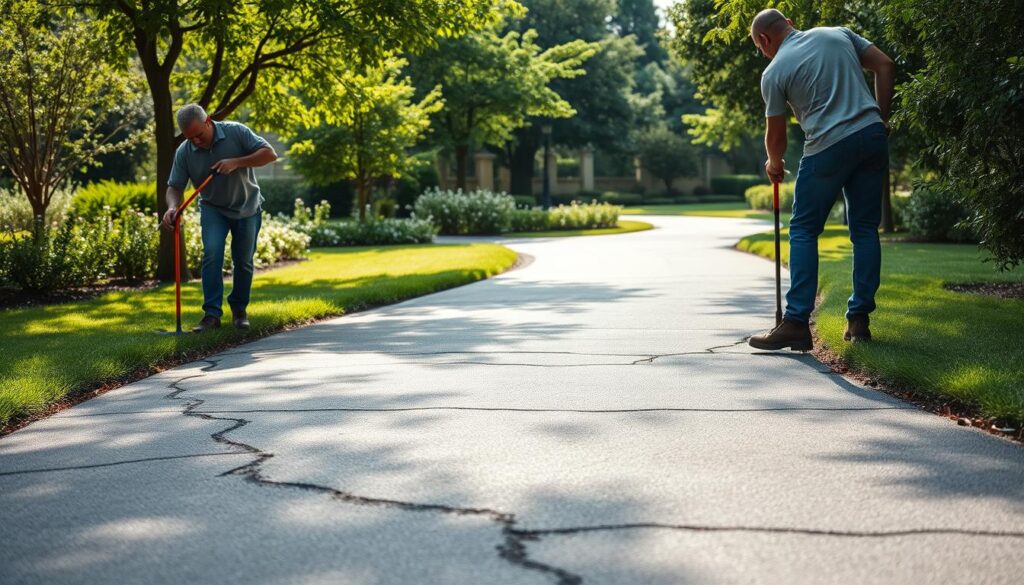
Pavement maintenance is an essential aspect of property care that is often overlooked. Regular upkeep is vital to extend the lifespan of your pavement and keep it looking its best.
Regular Cleaning Techniques
Keeping your pavement clean is the first step in maintaining its integrity. Dirt, debris, and weeds can cause damage over time. Regular sweeping and cleaning with a mild detergent can prevent this. For more stubborn stains, a pressure washer can be effective, but be cautious not to damage the pavement surface.
It’s also important to seal your pavement periodically. Sealing protects the pavement from the elements and reduces the risk of cracks and damage. The frequency of sealing depends on the type of pavement and its exposure to weather conditions.
Repair Strategies
Despite regular cleaning and maintenance, pavements can still suffer from wear and tear. Prompt repairs are crucial to prevent minor issues from becoming major problems. For cracks, using a suitable filler material can prevent further damage. For more extensive damage, professional repair or resurfacing may be necessary.
Regular inspections can help identify potential issues early. Look for signs of wear such as cracks, uneven surfaces, and discoloration. Addressing these issues promptly can significantly extend the life of your pavement.
11. Innovative Pavement Technologies
Advancements in material science and technology are paving the way for smarter, more sustainable pavement solutions. The integration of innovative technologies is transforming the pavement industry, enabling the creation of more durable, efficient, and environmentally friendly outdoor spaces.
Advances in Material Science
Recent breakthroughs in material science have led to the development of new pavement materials that offer enhanced performance and sustainability. For instance, the use of recycled materials in pavement construction is becoming increasingly popular due to its environmental benefits and cost-effectiveness.
Key advancements in material science include:
- Development of high-performance concrete with improved durability
- Use of recycled materials such as reclaimed asphalt pavement (RAP)
- Incorporation of advanced polymers and composites for enhanced strength
| Material | Benefits | Applications |
|---|---|---|
| High-Performance Concrete | Improved durability, resistance to cracking | High-traffic areas, industrial pavements |
| Reclaimed Asphalt Pavement (RAP) | Environmentally friendly, cost-effective | Road construction, pavement rehabilitation |
| Advanced Polymers and Composites | Enhanced strength, flexibility | Bridge decks, overlay systems |
Smart Pavement Solutions
Smart pavement technologies are revolutionizing the way we design and maintain pavements. These innovative solutions incorporate sensors, IoT devices, and advanced materials to create intelligent pavement systems that can monitor and respond to environmental conditions.
Some examples of smart pavement solutions include:
- Pavement-integrated sensors for real-time monitoring of temperature, moisture, and traffic
- Self-healing materials that can repair cracks and damages autonomously
- Energy-harvesting pavements that generate electricity from traffic and solar radiation
The future of pavement design lies in the integration of innovative technologies and sustainable practices. By embracing these advancements, we can create more efficient, durable, and environmentally friendly pavement solutions that meet the needs of modern infrastructure.
12. Budget-Friendly Pavement Ideas

Pavement design on a budget is achievable with the right materials and ideas. Creating an attractive and functional outdoor space doesn’t have to be expensive.
When planning a pavement project, one of the key considerations is the cost. Fortunately, there are several cost-effective materials available that can help reduce expenses without compromising on quality or aesthetics.
Cost-effective Materials
Some of the most budget-friendly materials for pavement include:
- Asphalt: A popular choice for driveways and pathways due to its durability and affordability.
- Concrete pavers: These offer a versatile and attractive solution, available in various shapes, sizes, and colors.
- Gravel: A simple, yet effective option for pathways and driveways, especially in rural or rustic settings.
These materials are not only budget-friendly but also offer a range of design possibilities.
Design Hacks
In addition to choosing the right materials, there are several design hacks that can help create a stunning pavement design on a budget:
- Use a simple pattern: Complex patterns can increase labor costs. Opting for a simple design can save money.
- Repurpose existing materials: Consider reusing or repurposing existing pavement or materials to reduce waste and costs.
- DIY where possible: Taking on certain tasks yourself, like preparing the site or laying pavers, can cut down on labor expenses.
By combining cost-effective materials with clever design strategies, homeowners can achieve a beautiful and functional pavement design without overspending.
13. Incorporating Color and Texture in Design
Enhancing pavement design with color and texture can significantly elevate the aesthetic appeal of outdoor spaces. By thoughtfully integrating these elements, homeowners can create inviting areas that are not only functional but also visually appealing.
Using Stained Concrete
Stained concrete is a popular choice for adding color to pavement design. It offers a range of hues and can be used to create decorative pavement patterns that add visual interest. The staining process involves applying a specialized stain to the concrete surface, which penetrates the material to create a rich, vibrant color.
The benefits of using stained concrete include its durability and low maintenance requirements. Unlike other coloring methods, stained concrete resists fading and can withstand heavy foot traffic, making it an ideal choice for high-traffic areas.
Textured Finish Options
In addition to color, texture plays a crucial role in pavement design. Textured finishes can add depth and visual interest to paved surfaces, creating a more engaging outdoor space. Various techniques can be used to achieve textured finishes, including stamping, scoring, and exposing aggregate.
| Technique | Description | Benefits |
|---|---|---|
| Stamping | Involves using molds to imprint patterns onto the concrete surface. | Creates realistic patterns, such as stone or brick. |
| Scoring | Entails creating grooves or lines in the concrete to achieve a specific design. | Allows for customization and can add visual interest. |
| Exposing Aggregate | Involves removing the top layer of concrete to expose the aggregate beneath. | Creates a textured, slip-resistant surface. |
By combining color and texture, homeowners can create unique and inviting outdoor spaces that reflect their personal style. Whether through stained concrete or textured finishes, the possibilities for enhancing pavement design are vast and varied.
14. Creating Multi-functional Outdoor Spaces
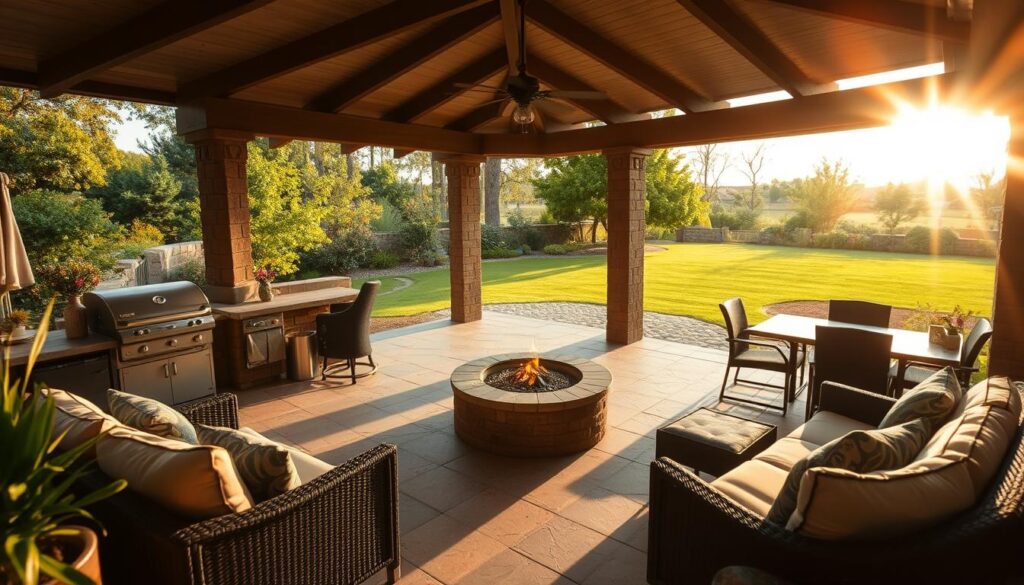
By incorporating various elements, you can turn your outdoor space into a versatile area that meets your different needs. This approach not only enhances the aesthetic appeal of your home but also increases its functionality.
Combining Pavement with Furniture
One of the key aspects of creating a multi-functional outdoor space is combining pavement with outdoor furniture. Thoughtfully designed pavement can serve as the foundation for different areas within your outdoor space, such as seating areas, dining spaces, or pathways.
- Choose outdoor furniture that complements the style and material of your pavement.
- Consider the scale of your furniture in relation to the size of your outdoor space.
- Use furniture with multiple functions, such as storage benches or coffee tables with built-in planters.
Engaging Activity Areas
In addition to combining pavement with furniture, incorporating engaging activity areas can further enhance the functionality of your outdoor space. These areas can include outdoor kitchens, fire pits, or playgrounds for kids, depending on your family’s needs and preferences.
- Identify the activities you want to accommodate in your outdoor space.
- Designate specific areas for different activities to maintain a sense of organization and flow.
- Incorporate lighting to extend the usability of your outdoor space into the evening.
By carefully planning and designing your outdoor space, you can create a truly multi-functional area that enhances your home’s value and your quality of life.
15. Exploring Cultural Influences in Pavement Design
From traditional patterns to modern interpretations, cultural influences significantly impact pavement design trends. The incorporation of cultural elements into pavement design not only adds aesthetic value but also creates a sense of identity and belonging.
Traditional Styles
Traditional pavement styles are often inspired by historical and cultural heritage. For instance, cobblestone patterns reminiscent of European streets or intricate tile work inspired by Mediterranean designs are popular choices. These traditional styles not only pay homage to cultural roots but also add a timeless elegance to outdoor spaces.
Key Features of Traditional Pavement Styles:
- Historical patterns and motifs
- Use of natural materials like stone and clay
- Incorporation of cultural symbols and emblems
As noted by landscape designer, “Traditional pavement designs serve as a bridge between the past and the present, creating a narrative that is both personal and cultural.”
Modern Interpretations
While traditional styles provide a rich cultural context, modern interpretations offer a fresh and innovative approach to pavement design. Modern designs often blend traditional materials with contemporary aesthetics, resulting in unique and functional outdoor spaces.
Characteristics of Modern Pavement Designs:
- Innovative use of materials and technology
- Integration with modern landscaping trends
- Emphasis on sustainability and eco-friendliness
“The future of pavement design lies in its ability to merge cultural heritage with modern sensibilities, creating spaces that are both beautiful and meaningful.”
By understanding and appreciating cultural influences in pavement design, homeowners and designers can create outdoor spaces that are not only visually appealing but also rich in cultural significance.
16. Conclusion: Crafting Your Perfect Pavement Project
Crafting the perfect pavement project involves more than just selecting materials; it’s about creating an outdoor space that reflects your style and meets your needs. By investing in good pavement design, you can significantly enhance your property’s value and appeal.
Investing in Quality Design
A well-designed pavement can transform your outdoor area into a functional and beautiful space. Exploring various pavement design project ideas can help you find the perfect fit for your home. Whether you’re looking to create a cozy patio or a stylish driveway, the right design can make all the difference.
Fostering Creativity
Don’t be afraid to get creative with your pavement project. Consider incorporating creative paving solutions that not only enhance the aesthetic appeal of your outdoor space but also provide functionality. By combining thoughtful design with innovative materials, you can create a truly unique outdoor living area.
